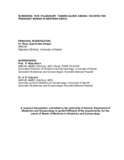| dc.contributor.author | Kosgei, RJ | |
| dc.date.accessioned | 2013-05-27T08:43:18Z | |
| dc.date.available | 2013-05-27T08:43:18Z | |
| dc.date.issued | 2011 | |
| dc.identifier.citation | Master of Medicine in Obstetrics and Gynaecology | en |
| dc.identifier.uri | http://erepository.uonbi.ac.ke:8080/xmlui/handle/11295/26096 | |
| dc.description.abstract | Background: Pulmonary tuberculosis (PTB) is the most common opportunistic
infection affecting HIV-infected patients including pregnant women, yet screening
for PTS is not routinely or systematically done in most Prevention of Mother-To-
Child Transmission of HIV/AIDS (PMTCT) programs. Diagnosis of PTB among
HIV-infected pregnant women poses unique challenges including: confusion of
constitutional symptoms of tuberculosis (TB) with those of early pregnancy,
reluctance to perform radiographic screening, lack of access to TB culture in
resource-poor settings and the paucibacillary nature of PTB among HIV-infected
patients leading to lower smear positivity rates than their negative counterparts.
Objectives: Among HIV-infected pregnant women participating in a standard
PTS screening program in Western Kenya to determine the: 1) prevalence of
latent tuberculosis infection (LTBI); 2) prevalence of active PTB and 3)
sensitivity, specificity and predictive value of the diagnostic tests in the diagnosis
of active PTB.
Methods: This is a cross-sectional study with an analytic component carried out
in Eldoret and Busia PMTCT clinics within the USAID-AMPATH partnership;
Western Kenya. All eligible HIV-infected pregnant women receiving care during
the five month study period and consented underwent: a standardized structured
symptom and sign screen, tuberculin skin test (mantoux), single view posterior
anterior dose regulated chest radiograph (CXR) performed after the first trimester
and sputum smear and cultures when cough was present.
Results: A total of 190 patients who met the eligibility criteria and consented
were enrolled. The study participants had a mean age of 27 years and a median
(range): age of 25(15-43) years; parity of 2 (0, 10); gravidity of 3 (1, 11);
gestation at enrollment of 26(10, 41) weeks and CD4 counts of 440 (24, 1408)
cells/lJl. Only 20% of the study respondents had a positive symptom and sign
screen. The prevalence of: LTBI as defined by a positive mantoux skin test was
40% and of presumptive active TB as defined by suggestive chest radiograph
findings was 5%. There was a notable representation of milliary TB; of the 10
cases with suggestive radiological features of active TB 3 had a milliary picture.
None of the 28 samples of sputum's collected were positive for Ziehl-Neelsen
staining or for mycobacterium tuberculosis culture. The role of different screening
procedures was inconclusive due to a small number of those with active TB and
the fact that there was no microbiological evidence of active TB.
Conclusion and Recommendation: LTBI infection is common in this population
with a remarkable percentage of chest radiographs suggestive of TB and a
notable milliary presentation. TB screening should be routine in all PMTCT care
programs in high TB and HIV burden areas. More studies are required to
determine best screening protocols as well as feasibility of Isoniazid Preventive
Therapy (IPT) in this population. | en |
| dc.description.sponsorship | University of Nairobi | en |
| dc.language.iso | en | en |
| dc.title | Screening for pulmonary tuberculosis among HIV-infected pregnant women in Western Kenya | en |
| dc.type | Thesis | en |
| dc.description.department | a
Department of Psychiatry, University of Nairobi, ; bDepartment of Mental Health, School of Medicine,
Moi University, Eldoret, Kenya | |
| local.publisher | Department of Obstetrics and Gynaecology | en |

